new posts in all blogs
Viewing: Blog Posts Tagged with: justin gray, Most Recent at Top [Help]
Results 1 - 10 of 10
How to use this Page
You are viewing the most recent posts tagged with the words: justin gray in the JacketFlap blog reader. What is a tag? Think of a tag as a keyword or category label. Tags can both help you find posts on JacketFlap.com as well as provide an easy way for you to "remember" and classify posts for later recall. Try adding a tag yourself by clicking "Add a tag" below a post's header. Scroll down through the list of Recent Posts in the left column and click on a post title that sounds interesting. You can view all posts from a specific blog by clicking the Blog name in the right column, or you can click a 'More Posts from this Blog' link in any individual post.

By:
Heidi MacDonald,
on 12/2/2014
Blog:
PW -The Beat
(
Login to Add to MyJacketFlap)
JacketFlap tags:
Jimmy Palmiotti,
Top News,
Crowdfunding,
paperfilms,
abbadon,
adaptive studios,
Interviews,
westerns,
Kickstarter,
justin gray,
Add a tag
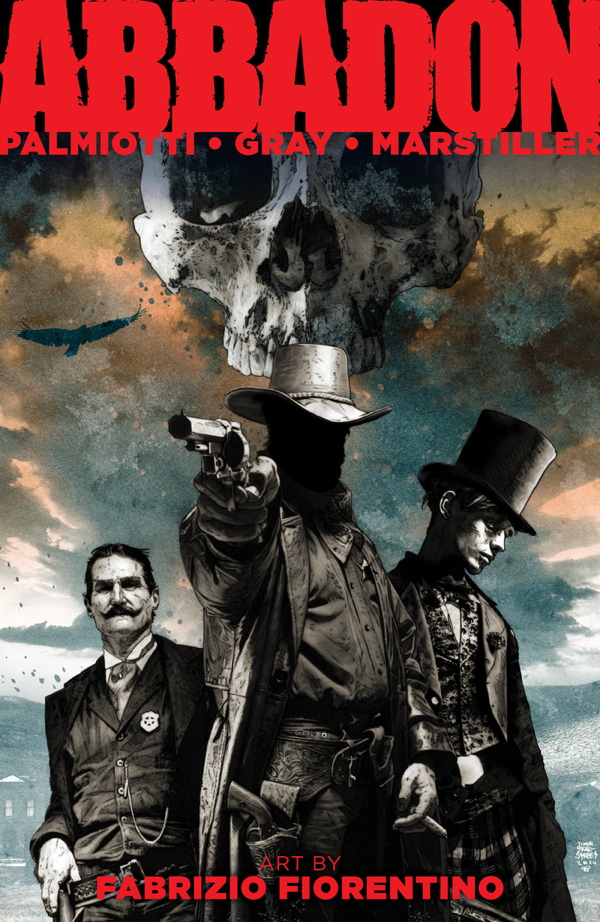
Kickstarter maestros Jimmy Palmiotti and Justin Gray of Paperfilms are at it again, this time with a Western, Abbadon, a tale of murder and mayhem set in a town full of just about every vice you can imagine. As with previous projects, the book is being funded on Kickstarter, and as of this writing is a few thousand dollars from making its goal, with two weeks to go.
It’s only the latest in a series of successful crowdfunding ventures for the Paperfilms team—we spoke with Palmiotti previously about Sex and Violence Vol 2 here and Denver here. This one has a new wrinkle: A partnership with Adaptive Studios, a new company that rescues abandoned IP. Palmiotti graciously answered a few questions about the project and Adaptive for The Beat.
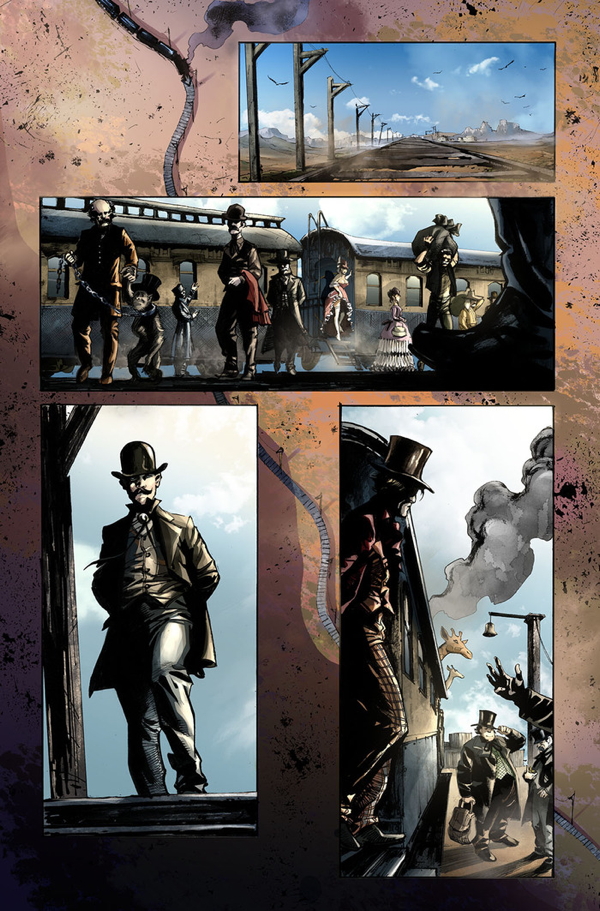
THE BEAT: Unlike some of your other Kickstarters this is an adaptation of an unproduced screenplay? Can you explain the origin of this tale?
JIMMY PALMIOTTI: Justin and I were introduced to the crew from Adaptive Studios by a mutual friend and I flew out to California to meet and talk to them about what our company, Paperfilms does, show them the books we have done and think about how we can work on some projects together. Since Paperfilms is just a couple of people, on our end, we can put books together, but we really don’t have time to do much else and we thought this partnership would be an interesting one since the crew at Adaptive specialize in a lot of multi media including publishing and have connections that we either don’t or don’t have the time to pursue since comics are a very labor intensive medium.
We spoke about a few projects while there, and one special one in particular; Abbadon. We read the screenplay a few times and after some back and forth, thought this would make a great graphic novel with us adding our take on it. Even more attractive to us was we felt it would be a great world building project since the bigger picture outside the graphic novel is the town itself and its place in history. So bottom line is we fell in love with the screenplay, did our take of it, built on it and then went out and put a team together to do the art on the graphic novel. What backers of the Kickstarter will get is a complete story, cover to cover, that has a bigger picture built into it that we hope to continue building on.
THE BEAT: Adaptive Studios’ business plan involving rescuing abandoned IP. What does that mean and how does your partnership work?
PALMIOTTI: Adaptive studios is rescuing some IP as well as working with us to create new properties and exciting graphic novels. With anything I do in this business, it’s all about relationships and partnering with like minds that share similar goals. We do it on every single project when working with artists and designers, creating what we think are the perfect representation of the story we are working on. When I met and spent some time with the crew at Adaptive, I found that we had a lot of the same goals in common which was really exciting. Adaptive studios totally respected with Justin and I did, and since they didn’t do graphic novels themselves, this partnership made sense to us. The best part of working with them is that they really love graphic storytelling and like us, have a love of all genres, so partnering with them has been a no brainer. On Abbadon, they brought the project to us and we fell in love with the idea and built on it. Our next project together will be an original idea we had that they liked, and we are going to see how we can make it all come together. Partnering with anyone doesn’t make sense unless the other person can bring something to the table and we think by working together, we can do some pretty amazing things. Abbadon is our first project and right now, the focus is on us to put together a stunning graphic novel and hopefully a successful Kickstarter campaign.
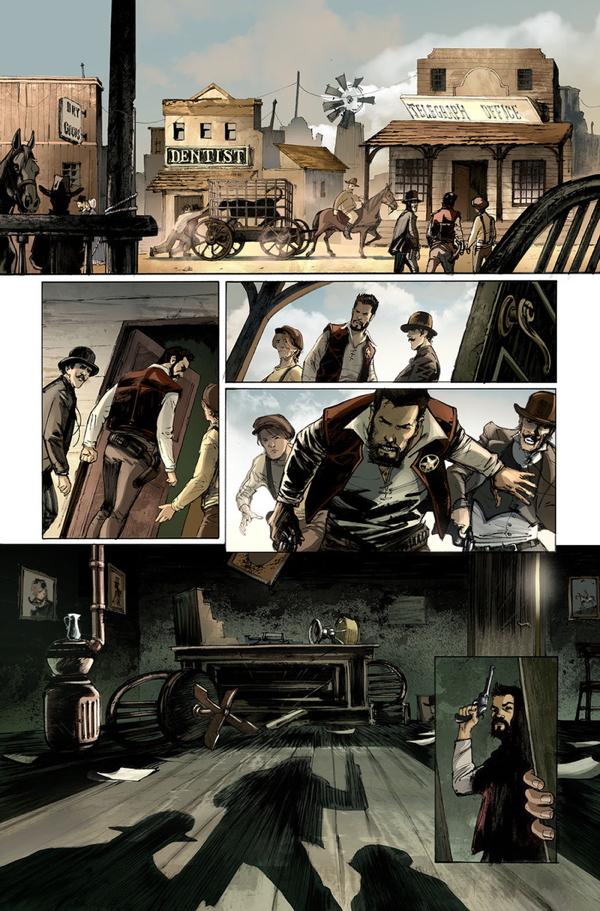
THE BEAT: You’ve returned to the Western genre, where you told so many great stories with Jonah Hex—did you feel you had more Western stories to tell?
PALMIOTTI: For me, it’s a genre that will never get old because the classic storytelling elements are always at play. A successful genre always has certain elements to it that have universal appeal, and with Abbadon, it’s no different. With Jonah Hex, we based all of our stories around a main character and it was a fun ride, but with something like Abbadon, we can tell a ton of stories based on the set up in this graphic novel we couldn’t tell in a book like Jonah because we were always dealing with content specific guidelines. The book was basically an all ages one and with Abbadon, we are telling a more adult story with elements that we would never get away with in a million years in Hex. So, yes, we have more stories to tell, but we want to tell them as we see them.
THE BEAT: I assume Abbadon refers to the town this is set in—some people may remember it as the name of an enigmatic character from Lost, but it’s also a Biblical term for a bottomless pit. How does the story reflect that?
PALMIOTTI: The town name is based on the biblical name and what it represents. The story and main character is the lawless town itself, and how the people in it are tempting fate on a daily basis. It’s a town where lust, greed, pride, and madness are right at home. It’s the most fun place you can go and it may also be the last place you visit as well, depending on your deepest desires. We took the worst of the classic old west and created a lawless sin city that the reader will find fascinating on many levels. The main story about a killer on the loose has everything to do with the story itself and the characters involved with the hunting of the madman. There is a lot of character development within the 64 pages and its something we have a lot of experience with .
THE BEAT: Reading the description on the Kickstarter page, this sounds like a western detective story. What else should readers know about what this story is about?
PALMIOTTI: The graphic novel Abbadon is set in the late 1880’s American West and features some of the most intriguing characters we have ever had the pleasure to work on. This is the story of an expanding wealthy city steeped in sin, where anything is possible if you have the money, influence and power to obtain it. Poised to become the next boomtown, Abbadon is plagued by a series of grisly murders heralding the arrival of U.S. Marshall Wes Garrett.
A legendary lawman, Garrett’s claim to fame is that he killed a notorious murderer, who cut a bloody swath across the country and left scores of mutilated men, women and children in his wake. Garrett’s arrival exposes the secret that Abbadon’s sheriff Colt Dixon has desperately been trying to conceal – the victims have all been mutilated the same way they were by the killer Garret stopped – a man some called a monster, but the papers called him Bloody Bill.
Garrett and Dixon reluctantly join forces and have opposing ways of dealing with the situation at hand as they try to uncover the killer’s identity in a town so full of corruption that everyone is a suspect. It really is a great story because the characters themselves are really interesting.
THE BEAT: You worked with Fabrizio Fiorentino on All Star Western—what does his art style bring to a Western comic?
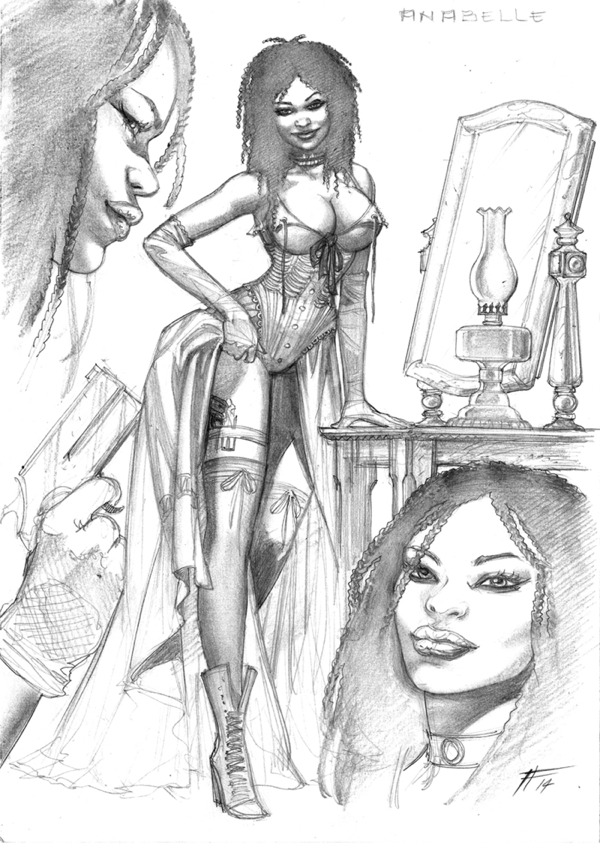
PALMIOTTI: Fabrizio knows his stuff and his illustrations and character drawings add a real world quality to the story and his storytelling and figure work breath life into our script in a way that is both beautiful and horrifying at the same time because of the subject matter. When we worked with him on All Star it was towards the end of the run and we wanted to find another project to work on together and this one was the perfect fit. The really cool thing about the book is each page is better than the last.
THE BEAT: The Western genre is considered kind of passe now, but western movies were once as popular as superhero movies are now. Do you think there could ever be a comeback for Westerns or has the time passed?
PALMIOTTI: I think there is always room for a quality story to be told no matter what the genre. Westerns are no different. I find it funny that the American western is a lot more fascinating to people living outside the U.S. and still has strong appeal.
THE BEAT: Any new features of your Kickstarter model with this project? It’s already more than half funded after a few days with minimal promotion (Editors note: , so you must be doing something right!
PALMIOTTI: We tried something different with this Kickstarter and focused on our usual backers first, and now we are spending the next few weeks going out and promoting the book to everyone. Only the people that have done Kickstarters realize just how much work it is to not only create the book, but getting a campaign together and especially promotion is a full time job. With our past Kickstarters, they always start out strong out of the gate and it’s the last few weeks we have to really focus on. The fun part of this process is that if we hit the number we are asking for, we can get really creative with the stretch goals and offer some really cool things to everyone backing Abbadon. At the end of the day, the art and story are the real sellers for this project and its up to us to deliver the goods. I am happiest to see that a lot of people are buying the digital version, which is only $5. I can see that these pledges are coming in from all over the world and I find this all to be really exciting. A big thanks for all of you that have supported this and past projects and to those new to Kickstarter, go have fun and explore the site. There are so many amazing comics and graphic novels to choose from.

Everyone should “Listen to JImmy” Palmiotti that is. The veteran writer, artist editor and publisher is one of the most knowledgeable comics people out there. With his collaborators from Paperfilms, Justin Gray and Amanda Conner, he’s made a small publishing enterprise out of kickstarting a series of graphic novels based on the European album format. The seventh, Sex and Violence Vol. II is ending in a few days and we advise you to get in on the Amanda Conner/Dave Johnson action as soon as possible — the books will not be sold in any other way. We talked to Palmiotti a few months ago when he was Kickstarting the SF tale Denver and got his overall thoughts on using Kickstarter as a platform. This time out we talk about the storytelling process,finding artists and also find out how Harley Quinn, which he co-writes with Amanda Conner, has become one of DC’s bestselling titles, with a huge female fan base.
The Beat: Sex and Violence is billed as stories of “crime, lust, and redemption.” Are these stories that you carried around for a while or did you sit down to think of them just for this volume?

Photo by Seth Kushner
Palmiotti: I can’t speak for Justin, but I have had the FILTER story idea for a while and was at one point going to pitch it as a series, but never got around to it. I reworked it so it can be enjoyed as a single story with a beginning and an end. The other short story was something I came up with and thought it might fit perfectly into the book. A lot of the time story ideas hit me and I keep files on them, waiting for the right time or opportunity to place them. I have another story that I want to do and hope we can get to a volume 3 of this series.
The Beat: I know Justin Gray wrote one of the stories, but can you tell us a little about each of the three stories, and what interested you enough in your two to tell the tale?
Palmiotti: Justin’s is called RED DOG ARMY and its based on actual history. Hitler launched a full-scale invasion on Russia called Operation Barabossa, and Stalin, reacting to this, authorized a special unit to train dogs as anti-tank weapons, sort of a suicide dog squad. It’s a real interesting setting to tell a story and beautifully illustrated by Rafa Garres whom we worked a number of time with on Jonah Hex. The next story is called DADDY ISSUES and is about a mother and daughter living in a trailer park dealing with the men in their lives. Its got a very tales from the crypt feel but works perfectly here. Romina Moranelli illustrated it and it’s just beautiful. The last story is called FILTER and it’s a look back on a killer’s life and the things he has done to get to where he is today. It’s dark and cruel and will stay with you for a while, I think. Vanesa R. Del Ray illustrates that story, an art student I met a couple of years ago that is making a name for herself all over now. All three stories work together pretty nicely.
The Beat: Your two stories sounds like they have fairly unsympathetic protagonists, which I know can be a challenge. How do you make dark characters like this compelling enough for the reader to want to follow along?
Palmiotti: Well, with Daddy Issues, you sort of understand what they are going through, but in the end, these are killers and you should be scared to be around them. With Filter, I set out to give the reader an understanding of how someone goes from bad to worse. The interesting aspect of the story is there is a level or redemption to the character that makes him a bit more sympathetic. I think the trick is to humanize the situation into something we can relate to so we understand the extreme reaction the character takes. Honestly, all of these characters are scary on their own level.
The Beat: How do you find artists for these? You’ve said it’s like casting, and as a sometimes editor, I know exactly what you mean. Sometimes you think of an element of a comics story and an artist just pops into your head with just the qualities that will make it work. Do you keep a physical or mental folder of artists you want to work with?
Palmiotti: I actually meet most of them at conventions. They come by and show me their work and I can feel the enthusiasm. I keep a file and also give them my contact and hope they follow through and we chat again. The people that I end up working with are the ones that stay after me and keep sending their latest samples. I try to stay up as well on who is new and exciting in the field best I can. I buy just about every new book that comes out, which my local retailer, Emerald City loves. The casting thing is a perfect way of explaining what I do for each story, It’s one of the most important parts of the job. I always say the Marvel Knights gig was all about casting the right people with the right characters. The magic happens after that.
The Beat: Do you ever write a story for a specific artist?
Palmiotti: All of the time. All three of the stories in Sex and Violence are catered to the artist. I may have an idea, but once I know who the artist is going to be, I change it to fit their style. In the case of All Star Western and Jonah Hex, we always wrote for the artist. I think that’s how we got their best work. Issue 34 of All Star was made for Darwyn Cooke and once we knew G.I.Zombie was going to be Scott Hampton, the book took a creepier, grounded tone. I didn’t want to fight against his style. I also think the work is better for it.
The Beat: I talked with you a few months ago for your Denver Kickstarter and it sounds like you really have crowdfunding down to a science. Were there any tweaks to the model this time?
Palmiotti: Yes, I did a few after the Denver Campaign. The first thing I did is stop offering the expensive packages overseas because we felt the price was too high to ask for the shipping and to be honest, a lot of the packages got lost or damaged pretty bad. The next thing was limit the prints because we felt there wasn’t as big a need for them this time, and last, since this is a follow up of a series of books, we went back to press and reprinted the first book with two brand new covers by Amanda Conner and Dave Johnson, knowing a lot of people did not get the first one that might be backing the new one.
The Beat: Your Kickstarter books seem to have a very European feel to them and not just because you often use foreign artists. Is that part of the inspiration for these books?
Palmiotti: It’s based on my love of European comics and artists. I grew up on Heavy Metal and with that steady diet; it was bound to have its influence. I also like to make the books mature audience books, again, a very European thing. I feel I do a ton of all ages work for the mainstream, so we get to unleash ourselves here and do whatever works for the story.
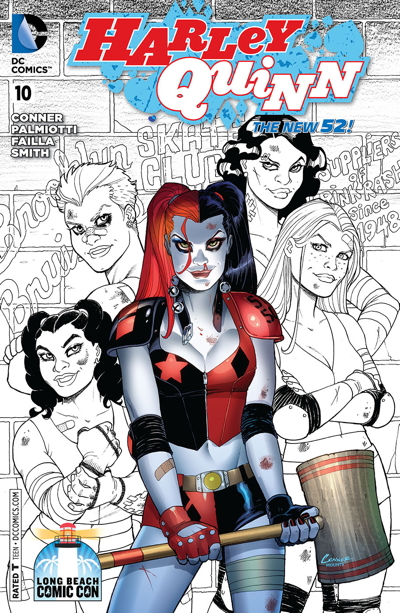 The Beat: On another note, Harley Quinn has been a huge hit for DC and for the Paperfilms crew. I saw you talking recently about the fact that it has a lot of women readers. I know it’s all still anecdotal for DC but this audience seems to be one that is really growing quickly. Can you talk about your own experiences with that?
The Beat: On another note, Harley Quinn has been a huge hit for DC and for the Paperfilms crew. I saw you talking recently about the fact that it has a lot of women readers. I know it’s all still anecdotal for DC but this audience seems to be one that is really growing quickly. Can you talk about your own experiences with that?
Palmiotti: Amanda and I have had a very busy year of conventions and signings and the thing we noticed from working on the Harley book is that the majority of the people coming up to us are females of all ages. We have only had this happen once before and it was for the Painkiller Jane series. The cool thing about this group is that we’ve had a large percentage telling us it’s the first comic book they ever bought and thanking us for not weighing down the title with continuity. They say they love that they can just pick up an issue and enjoy it without going broke or feeling left out and confused because they haven’t bought 15 other books. It’s something I am always aware of on all my books because I’m one of those people that, if I feel lost picking up a book, I never go back to it again.
What we are learning is that the traditional idea of done–in-one stories not selling in comics just doesn’t apply to the new audience buying the books, and believe me, most of that new audience are female. I think the problem right now is we have some people running the companies that just aren’t going out and trying new comics or interacting with the next wave of readers and keep pushing things the traditional way they did years ago. The retailers themselves are seeing this happening daily now and I feel it’s the reason Image comics will continue to grow and eventually outsell the big two, unless they start thinking outside the box and just make superheroes a PART of their publishing plan and not the entire thing and start looking at the different ways a superhero type of book can be done. Harley is one example , Hawkeye is another . The traditional graphics people associate comics with have been changing for years now and the market is embracing different looks and styles that are outside the house style and its pretty cool to see.
The thing that keeps me interested in comics is the prospect of new ideas, new voices and especially new methods of applied technology and connecting with the audience. It’s what keeps the Paperfilms crew and I trying new things all the time. As an example, we had a soundtrack scored on our last book DENVER and people loved it. That and the fact that people can go to Paperfilms.com and get digital downloads of our books, prints of Amanda’s work and copies directly from us is the next big for creators these days. That thing is the connection between the creator and the fan; something bigger companies have no real interest in promoting. This is also happening in all media. Things are changing fast, and for me, all for the better.
The Beat: You’ve made your Kickstarters a real cottage industry, What are your plans going forward? How many a year do you foresee doing and how long are you going to keep at it?
Palmiotti: I will keep making Kickstarters for as long as we have an audience for them. The people that back our Kickstarters are a lot of repeat customers and we are growing that fan base with every project. Our plans going forward are to do more of them and take on less work that we just do to pay the bills. Kickstarter has been a huge learning experience for us in so many ways. Each project teaches us what the audience wants from us. We look at the hard numbers, the comments and all the interaction and fine tune each and every new project to be able to connect better with the fans. We have only a few days left on SEX AND VIOLENCE VOL. 2 and after this, we have another book ready to roll that is a western graphic novel, something you would think we had enough of…but this one is different in a number of ways and we are super excited to announce it in a few weeks.
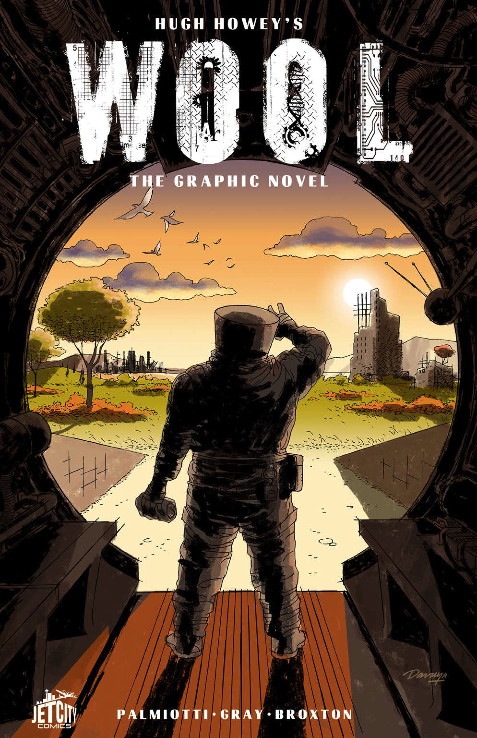
The graphic novel adaptation of Hugh Howey’s WOOL is now available in a serialized digital format via comiXology and Amazon.com. The adaptation, by Jimmy Palmiotti, Justin Gray and Jimmy Broxton, will be serialized in six parts for digital platforms. It’s one of the first offerings from Jet City, Amazon’s own in-house graphic novel arm. As a fan of the team, I have to say it looks good.
Single issues in the six-issue run will release every two weeks and sell for $2.99 on comiXology. The entire comics run will also sell for $4.99 as a Kindle Serial on Amazon.com, with new issues delivering automatically to customers on the same release dates, and as a $4.99 bundle on comiXology once all six issues are released. The print edition of the collected graphic novel will be available on Amazon.com and at other retailers in late August.
Howey’s dark, dystopian novel Wool (the first novel in the Silo Saga trilogy) was a New York Times, USA Today, and #1 Kindle best seller and is one of the most-reviewed science fiction novels ever on Amazon, with over 8,000 customer reviews.
See? Amazon does cool things too!
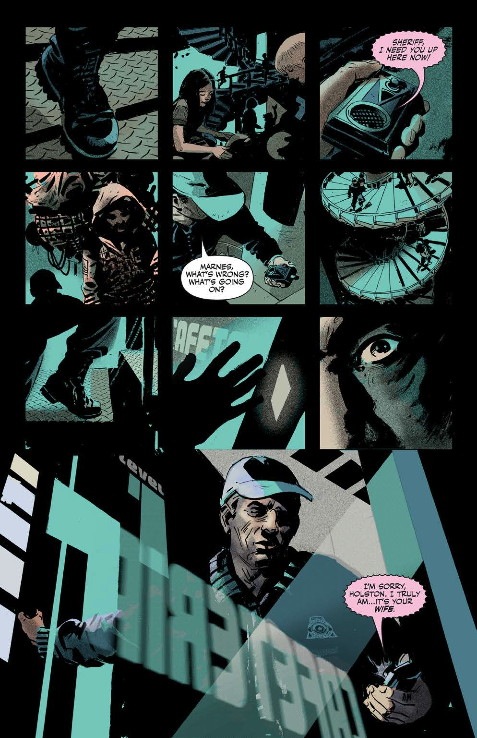
Contrary to the reports from this past week, writer Jimmy Palmiotti has taken to Twitter – and The Beat’s comment section – to state that All-Star Western has not been cancelled by DC.
And in fact, seeing as how it hasn’t been cancelled with issue #31 – how about we do a mini-campaign today to get some more people trying out the series?

I get a bit tired with cancellation-worshippers online, sometimes, who seem to wait until a series is cancelled before jumping into comment threads and declaring their own brilliance at having avoided the series completely. Or that they knew from the start that a series was doomed, because it tackled a different genre or featured a female lead or whatever. I sometimes think, y’know, maybe we should do more to offer a bit of support for titles we’re enjoying.
Of the thirty-ish issues of All-Star Western which have come out so far, I’ve read probably around twenty of them – and I’ve enjoyed the majority of what I’ve read. There’s been a steady creative team in the form of Jimmy Palmiotti, Justin Gray and Moritat since the very first issue – back in 2011 – and they’ve tackled a mainstream DC title which is set in the distant past and tells western stories.
That is, surely, one of the things we want to see more of from DC? Risks like that, with a consistent creative team? So what I’d suggest, today, is - you try an issue. The current arc has been teaming lead character Jonah Hex up with a variety of different characters – from Superman to Swamp Thing – for a series of one-and-done issues. If you’d like to see what it’s like when a creative team get given a longer leash by their publisher – head to Comixology today and try an issue.
Or, when the next issue – issue #29 - is released next month and you see it in your local store… try it? At most, you’ve lost a few dollars you might’ve spent on a coffee. And maybe you’ll find a new comic you like.
I might try this a few times over the next few months, perhaps, on The Beat. Looking at the indie sales chart here on the site, there are many other acclaimed series which could always do with a sales boost. And hey, we have a bit of a soapbox here that I can use, people read the site a little – what if once a fortnight or so we gather together and offer a little surge of support for a series we think more people should read? Head to ComiXology or our LCS and try something we’ve seen on the shelves, but never tried until now.
In the comments below, please let us know if you try an issue of All Star Western, and let us know if you enjoyed it, too! And what other books do you think should be getting a little more attention from readers? I know the majority of fans don’t take pleasure from hearing that a comic has been cancelled – which titles would you like to try and give a Beat Boost to? Maybe we can create a ripple effect! Maybe?

By:
Heidi MacDonald,
on 3/15/2013
Blog:
PW -The Beat
(
Login to Add to MyJacketFlap)
JacketFlap tags:
News,
Reviews,
Comics,
Dark Horse,
Image,
Vikings,
World War II,
Oni,
Phil Noto,
dave stewart,
Assassins,
Mike Mignola,
justin gray,
Joelle Jones,
Oni Press,
Image Comics,
Jimmy Palmiotti,
Top News,
John Arcudi,
Cullen Bunn,
Jason Latour,
Helheim #1,
Sledge-Hammer 44,
Trigger Girl 6,
Add a tag
I noticed a common feature in the comics I was reading this week, a feature that made them all compelling as stories: the role of the underdog pitted against overwhelming odds. Seeing the psychological reactions of the characters was an important part of the ride, but excellent artwork, particularly in executing fight scenes, left me more than impressed with each one. HELHEIM #1 (out March 6th), TRIGGER GIRL 6 (out March 13th), and SLEDGE-HAMMER 44 (out March 13th) strike a fluid balance between characterization and action, always a kind of brass ring for comics creation, though sometimes a little difficult for readers to come by.
[Spoilers for HELHEIM #1, TRIGGER GIRL #6, and SLEDGE-HAMMER 44 #1 below]

[HELHEIM #1]
HELHEIM, from Oni Press, kicks off a new series, and so has a great deal of storytelling to accomplish in a single issue. It does this with axes, axes, and more axes. Though it’s true there are plenty of axes, there’s also a lot more to HELHEIM, a tale “of the North” featuring what I’ll assume from the title are Vikings. Joelle Jones (FABLES) illustrates the issue, and her style is not only eye-catching but moody. Her characters in profile resemble figures from Viking-age artifacts but also have an angularity to their movement that really establishes the world of HELHEIM. I mentioned fight-scenes. These are equally unique and captivating. Though pseudo-medieval fight scenes are common enough in comics to keep you from really paying attention to the detail of their rendering, Jones breaks down that familiarity through unique panel layouts, occasionally rounded to depict landscape or full-page with overlaid panels to create emphasis. If she impresses with her Vikings, she’s even more at home with her artwork conjuring the undead, which sets up the forthcoming themes of the series well. There’s a kind of epic weight to some of her panels that simply stays with you, a sign of excellent art.
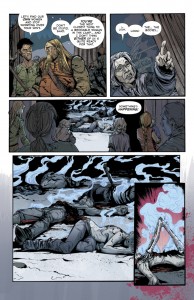
[HELHEIM #1]
Writer Cullen Bunn keeps up the pace of the story with driving action, and combines many of the tropes from medieval sagas without slowing things down. He establishes the role of kin relationships straight off the bat as central hero Rikard tries to save his wounded son, but ultimately has to leave the corpse behind, and then engages with both his father and other relatives at their timber fort under siege. Family relationships make for good drama, particularly in 580 AD. This forms a large part of the psychology of Rikard in his role as protector, but also as father and son. But it’s the supernatural elements Bunn includes that I particularly applaud, from Rikard seeing a vision of his own bleeding ghost predicting his imminent death (this happens in Irish Sagas of the period, and perhaps Viking too), to the rising corpses of his recently slain grotesque foes pursuing him. These are some of the elements that make Viking sagas great in their own right, including blue-faced undead who haunt houses and pound on the roof, calling the cowering inhabitants by name. Bunn brings the most evocative moments of Viking tales to new life, but isn’t afraid to introduce his own developments, like the series premise set up in #1, that Rikard can be resurrected by witchcraft to act as a vengeful Franken-Viking. If the rest of the series shows such careful consideration as this issue, the combination of powerful artwork and strong storytelling will be well worth the read.
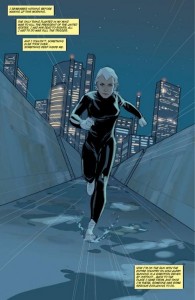
[TRIGGER GIRL 6]
TRIGGER GIRL 6, the compilation volume of the series that appeared in the too soon cancelled magazine CREATOR OWNED HEROES, but thankfully presented as a whole by Image, already took fans by storm in 2012, but seeing the series in one unit was entirely worth the wait. Phil Noto’s artwork on the series is simply dazzling, from sleek line-work to color themes. Noto has the uncanny ability to present moments of stillness in the midst of action that creates a sense of vertigo for the reader. Since about two thirds of the story-line involves clone Trigger Girl 6’s attempt to assassinate the president of the USA, hang on tight. The plot calls for handling animals in a majestic, impressive role and Noto proves up to the challenge, too, making you wonder if there’s anything that’s not his forte when it comes to comic art. The pastel hues of the early stages of the story also merge into ethereal jungle settings within any jarring sense of transition. From near-future technology to talking animals, Noto knows the score.
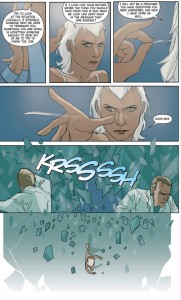
[TRIGGER GIRL 6]
Jimmy Palmiotti and Justin Gray bring us a story in TRIGGER GIRL 6 that defies you to doubt its central truths. In an included interview, the collected volume expresses Palmiotti and Gray’s concern about big corporations, and the increasingly “overpopulation and greed” in modern society that gives weight to the whole TRIGGER GIRL concept. It’s not just a beautifully drawn assassin story (though that would probably be enough to sell the book), but it’s also a commentary on social conscience. The character of Trigger Girl 6 also develops and expands for the reader, drawing us into her psychology. While TG 6 is silent and therefore mysterious in the early stages of the story, after her escape from government interrogation, Palmiotti and Gray also include inner monologue text boxes that emphasize her own internal questions and search for identity. Though this is often a common feature of sci-fi clone stories, it’s always compelling when it’s handled well, and Palmiotti and Gray manage to convey a great deal about her personality in such a brief story arc. What’s most impressive about the story, though, is that the writers bring out their big themes in what’s effectively a single-issue finale as TG 6 discovers the biological haven where she was born and the scientifically enabled talking animals who have created her. It’s a wild idea, but it doesn’t feel forced in the least, and engages with a long history of social commentary and sci-fi literature that reflects on human behavior and finds it lacking. To say the story has heart would be an understatement; it has compassion and concern. The fact that Palmiotti and Gray feel that they can reach comics readers with such a weighty message elevates the medium in all the right ways.

[SLEDGE-HAMMER 44]
SLEDGE-HAMMER 44 #1, from Dark Horse, introduces a character from Mike Mignola and John Arcudi who has his own mysterious origins and motivations. Like a lot of intriguing Dark Horse comics set in the HELLBOY universe, WWII and the Nazi legacy feature, but this story focuses on the role of fighting men and establishes a skillful balance between the fantastic and the historically grounded. Jason Latour’s artwork has a lot to do with the success of this balance. His blend of stylized linework with military detail suggests 1940’s comic art dealing with war, and the fairly unusual (from Dark Horse) sepia and muted tones of Dave Stewart’s color palette set the comic apart as something a little different. It hints that the war, and its own epic aspects, are as important as the heroic figure that the comic introduces: Sledge-Hammer. But for steam-punk and technology fans, there’s also plenty to love in Latour’s artwork. Mike Mignola’s cover art set up the design of Sledge-Hammer’s mechanoid appearance in his characteristic wood-block imprint style, but Latour also brings a sense of the human to Sledgehammer’s anatomy and appearance, from the first panel where he’s introduced, looming large in his army jacket, to his explosive one-man operation fight scenes where he takes a beating from a Nazi robot. The comic has got atmosphere in spades thanks to the artistic team work involved.
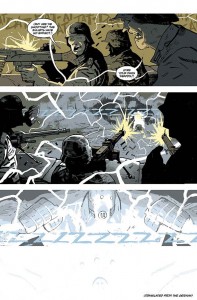
[SLEDGE-HAMMER 44]
Mignola and Arcudi also craft a story with universal appeal through grounding the reader in the perspective of soldiers watching the mysterious Sledge-Hammer operation in action, as well as through giving Sledge-Hammer a speaking role even this early in the story-line. He may be a being of few words, but urging the soldiers to leave him behind and save themselves sets Sledge-Hammer up as a classic heroic being, capable of miscalculation (he seems not to have seen the Nazi robot coming), but also of personal sacrifice. It’s also a wise move that Mignola and Arcudi don’t give too much away about Sledge-Hammer’s mentality, leaving the reader to make assumptions and hang on for the next installment to learn more about whether this metal soldier has any other human characteristics, and what exactly motivates his driven actions against the Nazis. It’s a comic staged for a grand entrance of a unique character, and all the better for picking out the details of wartime experience in Europe through secondary characters. Like many projects that Mignola works on, the storytelling feels decompressed to allow the images to tell their own tale, often with only a few panels per page. The comic calls for more dialogue, actually, than many of Mignola’s works, to create a sense of experiencing conflict on the ground during WWII. The story feels particularly unencumbered by having to fit into any specific moment in a wider mythology, and for that reason it has an overpowering sense of being something new, brisk, and somewhat unpredictable. If you read issue #1, it’ll be almost impossible not to follow SLEDGE-HAMMER into its second issue whether due to its lavish homage artwork or its fresh storytelling, but most likely a combination thereof.

[SLEDGE-HAMMER 44]
These three comics display a strikingly high standard for comic artwork, really setting their artists loose to develop an aesthetic appropriate to the worlds they’re creating. It helps that the reader is following central characters into conflict and watching them battle it out against the odds within their own stories. This gives action scenes even more of an edge and also leads the reader deeper into the psychological layers of the storytelling involved. All three comics celebrate the role of the hero, taking traditional elements and redefining them according to the personal vision of their respective creative teams. HELHEIM #1, TRIGGER GIRL 6, and SLEDGE-HAMMER 44 #1 prove that you don’t have to choose between spectacular art or strong storytelling in comics: you can actually find them both in one package if you’re lucky.
Title: HELHEIM #1/Publisher: Oni Press/Creative Team: Cullen Bunn, Writer, Joelle Jones, Illustration, Nick Filardi, Colors, Ed Brisson, Letters
Title: TRIGGER GIRL 6/Publisher: Image Comics/Creative Team: Jimmy Palimiotti, Justin Gray, Writers, Phil Noto, Artwork, Bill Tortolini, Letters, Design
Title: SLEDGE HAMMER 44 #1/Publisher: Dark Horse Comics/ Creative Team: Mike Mignola, John Arcudi, Writers, Jason Latour, Artwork, Dave Stewart, Colors, Clem Robins, Letters
Hannah Means-Shannon writes and blogs about comics for TRIP CITY and Sequart.org and is currently working on books about Neil Gaiman and Alan Moore for Sequart. She is @hannahmenzies on Twitter and hannahmenziesblog on WordPress.

By:
Heidi MacDonald,
on 3/14/2013
Blog:
PW -The Beat
(
Login to Add to MyJacketFlap)
JacketFlap tags:
Kickstarter,
justin gray,
Jimmy Palmiotti,
Amanda Conner,
Jimmy Broxton,
juan santacruz,
Reviews,
Comics,
Sex,
violence,
Add a tag
by LTZ
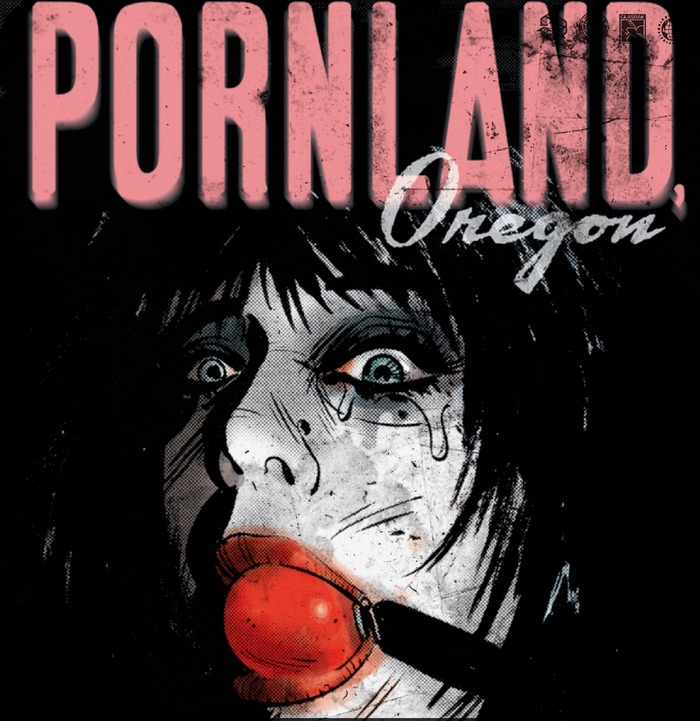
A while back, the Beat’s own Henry Barajas – tireless observer of Kickstarted comics that he is – took some time to preview a crowd-funded book by Justin Gray, Jimmy Palmiotti, Jimmy Broxton, and Juan Santacruz. Sex and Violence, Vol. 1 was laid bare (spread-eagle, perhaps) to its supporters this past week, after reaching its funding goal. The only hurdle yet to cross is for Palmiotti, Gray, and cover artist Amanda Conner to actually sit down and sign the damned things. I was part of the crowd that funded Sex and Violence; I expect I’ll get my copy in the mail any day now. In that copy, and in everyone else’s, too, there will be my name (my government name, my “goes on job applications” name), thanked for helping to finance, well, sex and violence.
I wonder if this bizarre offshoot of buyer’s remorse is common amongst Kickstarter supporters. The thing is, it’s not exactly remorse. It’s more like Schroedinger’s cat, where a funded project exists in a quantum state of being both satisfying and regrettable until you get your copy and find out for yourself. “So, goofus,” the dialogue begins, “why did you throw money at it if you weren’t sure you’d be happy with it?”
I’m not sure I have a good answer for that. I like Jimmy Broxton’s art, I guess. Getting an Amanda Conner art print or whatever else is pretty cool. As writers, Palmiotti and Gray have yet to grievously offend me, but then again, I’m not exactly snatching Freedom Fighters off the racks so roughly that the staples kink. It almost, maybe, makes a little more sense when I take the long view and consider the status quo of adult-people comics today.
Joe Casey, agent provocateur, just released a comic called Sex, which I saw praised on Twitter as “the most 2003 comic of 2013.” Brandon Graham’s Multiple Warheads, a book I love without qualifiers, started as a porno gag strip in an NBM anthology. Matt Seneca’s Very Fine Comix debuted with Daredevil 12”, a XXX Marvel comic spoof; Jane Mai just put out Blumpkin Spice Latte, a zine that’s 99% dick talk (with the best title of 2012). Sex is in the air in comics, these days, but it’s kept its edge, sticking mostly to the dim corners or weird vortices of the market.
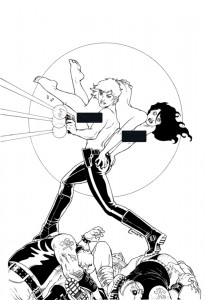 Violence, of course, is the foundation modern comics were built upon, and the sword that they live and die by to this day. I shouldn’t even need to point out examples, but the “big moments” in the Diamond-distributed scene always revolve around bloody carnage. Think Damian Wayne, freshly skewered. Glenn from The Walking Dead: turned into a piñata. Avatar Press is its own thing entirely. Both Mark Millar and John Romita’s certified hit Kick-Ass and Frank Cho and Joe Keatinge’s upcoming Brutal have promo art that looks jacked straight from the cover of Pantera’s Vulgar Display of Power. DC Comics’ big multimedia tie-in for the quarter isn’t just a fighting game, it’s a fighting game built by the people who make Mortal Kombat.
Violence, of course, is the foundation modern comics were built upon, and the sword that they live and die by to this day. I shouldn’t even need to point out examples, but the “big moments” in the Diamond-distributed scene always revolve around bloody carnage. Think Damian Wayne, freshly skewered. Glenn from The Walking Dead: turned into a piñata. Avatar Press is its own thing entirely. Both Mark Millar and John Romita’s certified hit Kick-Ass and Frank Cho and Joe Keatinge’s upcoming Brutal have promo art that looks jacked straight from the cover of Pantera’s Vulgar Display of Power. DC Comics’ big multimedia tie-in for the quarter isn’t just a fighting game, it’s a fighting game built by the people who make Mortal Kombat.
So in this rough-sex-and-eyeballs-popping milieu, Sex and Violence seemed like a romp. Sure, it was being pitched as tawdry, sleazy, exploitative, and unshakably macho despite itself… but sometimes the grindhouse is the place to be. All of this is very much after-the-fact justification, but it seems to add up. But that just takes us back to Schroedinger’s cat. It could be fun and trashy. If could just be trashy and a little sad. I paid my admission, so the least I can do is find out.
There are two halves to Sex and Violence. You’d think that with the title structured the way it is, this duplex approach would lend itself to a sex story and a violence story. It almost does (one tale is certainly more violent than sexual, and vice versa for the other), but not enough to comment on the idea at any other point in this piece. The book starts with “Pornland, Oregon,” illustrated by Jimmy Broxton. In what starts as a sideways riff on the movie Hardcore, a young woman is made a deep web sensation forevermore by being murdered in a snuff film. As it turns out, in one of those funny coincidences life likes to play, her grandfather is a retired Mafia hitman, and all expected murders and executions follow in due course. The second story, drawn by Juan Santacruz, is “Girl in a Storm,” about a lesbian NYPD officer who becomes obsessed with spying on her beautiful neighbor, and has to deal with the small complication of that neighbor already having a woman to keep her bed warm. Things, as they must, get more sordid from there.
So is it any good? Jimmy Broxton’s minimalist (and very British, in a way I can’t put my finger on) style sells “Pornland” rather well. Abetted by Challenging Studios’ color palette of blue, grey, purple, and what I can only call “various shades of Dave Stewart red,” Broxton makes “Pornland” into something not unlike the crime media of the 70s, when character actors could still look like the bottoms of feet: Get Carter, The Outfit, The Squeeze, some imaginary episode of The Rockford Files with more exposed breasts… In fact, the plot of the thing is pretty much Get Carter with some serial numbers filed off, and things like “a vaguely sympathetic hero” and “romance” bolted on like a new spoiler on a Gremlin. That’s not bad, mind. If you’re going to be something in the avenge-young-relative sub-genre, Get Carter is really what you want to be.
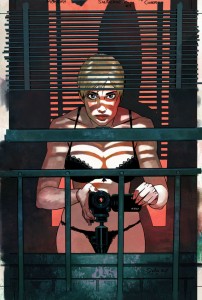 On the other hand, “Girl in a Storm” is just… there. The story strains to be Brian de Palma, which is a noble ambition until you realize that Brian de Palma is usually straining to be other people (in this case, a Sapphic voyeur version of Rear Window) – it’s a well that quickly dries up. Juan Santacruz is a veteran superhero artist, and that’s a downside here. Instead of a claustrophobic, psychologically maladjusted story of obsession, passion, forbidden desire, violence, and all those other things that we pretend not to love, the leggy all-but-baby-oiled figures and brightly-lit colors give the whole thing a plastic shine. The look of the strip – which, in a strip about looking, is really the most important thing on multiple levels – isn’t enough to elevate an uninspired script, and both sides end up worse for it. If “Pornland” is Get Carter, “Girl in a Storm” ends up as a post-depilation-culture take on something like a Christina Lindberg movie, and not one of the really twisted, memorably corpse-mutilating ones like Thriller.
On the other hand, “Girl in a Storm” is just… there. The story strains to be Brian de Palma, which is a noble ambition until you realize that Brian de Palma is usually straining to be other people (in this case, a Sapphic voyeur version of Rear Window) – it’s a well that quickly dries up. Juan Santacruz is a veteran superhero artist, and that’s a downside here. Instead of a claustrophobic, psychologically maladjusted story of obsession, passion, forbidden desire, violence, and all those other things that we pretend not to love, the leggy all-but-baby-oiled figures and brightly-lit colors give the whole thing a plastic shine. The look of the strip – which, in a strip about looking, is really the most important thing on multiple levels – isn’t enough to elevate an uninspired script, and both sides end up worse for it. If “Pornland” is Get Carter, “Girl in a Storm” ends up as a post-depilation-culture take on something like a Christina Lindberg movie, and not one of the really twisted, memorably corpse-mutilating ones like Thriller.
So this is what’s going to have my name tucked away in it, until we’re all dead and beyond. I don’t feel particularly embarrassed about this, I suppose. I probably should, and the sting is probably lessened by my name being so generic as to sound like an ethnic take on “John Smith.” Only half of Sex and Violence is really any fun – a statement more true than I intended it to be when I typed it – and I overpaid, based on that math. It’s not egregiously offensive (by comic book standards) and it’s not a work of genius. It just exists, and me with it, twins conjoined at the donation. It’s hard to work up a head of steam one way or the other when both pleasure and disappointment come mild.
LTZ sells comic books, and infrequently contributes to the Beat. He even more infrequently contributes to his own site, Nowhere / No Formats. He tweets about how hard this rigorous schedule is at @less_than_zero.

By:
Heidi MacDonald,
on 12/8/2012
Blog:
PW -The Beat
(
Login to Add to MyJacketFlap)
JacketFlap tags:
Reviews,
Comics,
Image,
Dean Haspiel,
Scott Morse,
Evan Dorkin,
Darwyn Cooke,
justin gray,
Indie Comics,
Jimmy Palmiotti,
COMPLEX,
Chris Miskiewicz,
seth kushner,
Top Comics,
Jeffrey Burandt,
"Blood and Brains",
"KillSwitch",
"Meatbag",
"The Deadly Book",
Brandon Seifert,
Christopher Irving,
Creator Owned Heroes,
Creator Owned Heroes #7,
Jerry Lando,
Paul Mountis,
Steve Niles,
Add a tag
Earlier this week, Jimmy Palmiotti announced that the noble experiment CREATOR OWNED HEROES would conclude after its 8th issue. Over the course of the magazine’s publication, outreach on social media emphasized the need to raise awareness and increase solicitation from comic shops to keep the multi-contributor series in motion. Consistently strong reviews appeared on media, fan, and blog sites with each issue, and as COH developed, it continued to raise the bar on high-quality content. The ascent has been dizzying, and exhilarating for readers and comics creators alike in an era of increasing awareness about the ups and downs of self-publication. It has been like watching crucial surgery in a live operating theatre in the hands of celebrated practitioners where the audience has come to play an integral role. The life of the patient has depended on their rapt attention in increasing numbers. Depending on your perspective, issue #8 will represent the final bow of an effort exploratory and unique, or perhaps somber flat-lining during a risky procedure that practitioners will attempt to learn from for some time to come. But either way, COH won’t be concluding in obscurity. Ironically, there will be more people in the operating theatre than ever before to witness its final moments and draw their own conclusions.
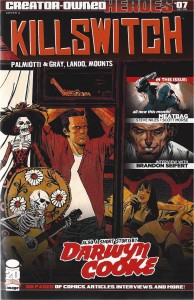
CREATOR OWNED HEROES #7 represents a particular crescendo in the magazine’s development, a point at which even those who have been following the series closely lean forward, aware that something unprecedented is unfolding before their eyes. It expresses a remarkable energy and a confluence of its methods and its goals due, in part, to the team of contributors it brings together. As Justin Gray says introducing his Brandon Seifert interview, “When we started Creator Owned Heroes, it wasn’t just a desire to self-publish; it was a multilevel dedication to comics that were being produced outside the work for hire landscape”. Gray also cites “ a fundamental desire to tell stories” as a common feature among the creators chosen as contributors. Issue #7 is a tour de force illustration of those criteria.
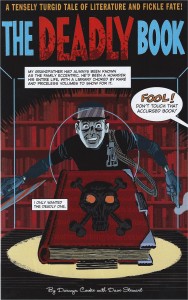
The powerhouse comic in the anthology is clearly Darwyn Cooke’s irreverent, rapidly paced and verbally exuberant “The Deadly Book”. Cooke hits high notes across the board of comic storytelling elements, from a lush, contrasty color palette in sky-blue, blood-red, and ink-black, to unexpected vantage points, compressed action, and even a very indie take on relating past events in short form via substantial narrative blocks. The comic displays the best possible outcomes for a skilled creator taken off the leash to tell the kind of story that they want to tell in the way that they see fit to tell it.
Jimmy Palmiotti, Justin Gray, Jerry Lando, and Paul Mountis follow Cooke with “Killswitch” in its 3rd installment of 4. They put the action back in indie in a big way and display a particular virtuosity in reversing a typical paradigm in espionage/hitman themed comics. Rather than telling the story with several panels, if not pages, of heavy exposition followed by the action sequences readers have been waiting for, they manage to reveal a wealth of exposition during an installment that, arguably, is one big action arc. They keep it interesting by demanding the reader put the pieces of information together for themselves, from Kill Switch’s complicated pseudo family life to the developing role of a nemesis. Rather than just telling a story well, which is a quite an achievement in itself, they manage to tell a story differently, once again illustrating the surprising results when creators have sufficient room for experimentation.
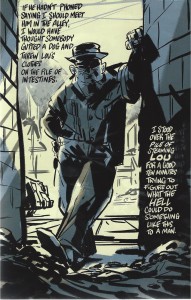
Steve Niles and Scott Morse bring an even greater variation in style and content to COH #7, pushing the boundaries of typical narrative structures while giving a nod to still-rich veins of comics tradition. They break down confined panel layout, and do away with textboxes and speech balloons to tell a noirish private-eye tale with disturbing gusto. “Meatbag’s” full page-feel conjures up Eisner’s SPIRIT while the first-person narrator places the storytelling firmly in Raymond Chandler territory. Add to these elements the use of limited color palette, heavy brush-stroke illustration and moody lettering, and you’ve got a finely balanced combination of old and new, making this a 21st century comic with a lot of room for innovation.
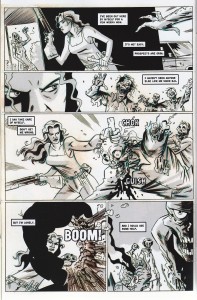
Then we have zombies. The subject-matter is in danger of being done into the ground in the TV, film, and comics medium, but in keeping with the challenges set by COH #7, Dean Haspiel and Jeffrey Burandt deliver something readers have simply never seen before, imploding any expectation of the familiar. Haspiel’s zombie artwork avoids the basic emphasis on blood and gore flooding zombie media these days and emphasizes, in a visceral way, the disjointedness of decomposition through trailing limbs and chunks of missing anatomy. This makes Haspiel and Burandt’s heroine seem all that much more solid, active, and vital as she spikes a zombie noggin and blasts through zombie brains. This is zombie-storytelling streamlined to basic psychological elements: loneliness, companionship, and, finally, the pulse-poundingly unexpected that makes the genre so popular. “Blood and Brains” retools zombie narrative by removing excess accretion and celebrating its potential in creator-owned style.
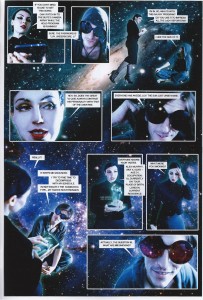
Photo-comic COMPLEX: “Luv_Underscore’s_U” by Seth Kushner, Chris Miskiewicz, and Dean Haspiel reminds us that the comics medium is expansive, varied, and should never feel too comfortable. Katelan Foisy and Miskiewicz star in this futuristic psychological landscape where the solid realities of the photo images help readers keep a grip on the otherwise shifting definitions of reality in the narrative. There’s a subtle ambiguity in the nature and future of technology, it’s use and misuse to contribute to human experience, and on the whole the photo-comic not only tells the reader but shows the reader the spell-like suspension of disbelief comics, in the right hands, are still capable of creating.
The prose content of COH #7 also contributes greatly to the purpose of the series, present from issue #1, of taking readers inside the world of creator-owned projects, an on the ground approach that not only educates but instructs. Justin Gray’s interview with Brandon Seifert allows the reader to hear straight from the horse’s mouth, “Want to be a writer? Start writing. It’s that simple, and that hard”. A “social media press conference” included in the issue also brings together advice and insight from creators and Steve Bunche concludes a full-on bootcamp for aspiring comics writers with plenty of solid advice that may seem counter-intuitive like “avoid topical subjects”. It’s clear that the meta-text of COH #7 is not there simply to sell books but to actually aid aspiring creators in avoiding the pitfalls that contributors have faced.

From issue #1, COH has given a strong impression of community among indie creators, and #7 continues to follow through in inclusiveness. A major profile of legendary tide-fighter Evan Dorkin, written by Christopher Irving, and photographed by Seth Kushner, only further illustrates the point. Creator-owned projects may seem like a new thing, maybe even a fad, but they aren’t. They’ve been breaking new ground for some time, and there’s plenty to be learned from observing the struggles of greats like Dorkin. Dorkin’s legacy in brief could be summed up in his statement: “I’ve come to hate when people say ‘Don’t get into comics’. I learned to say ‘Fuck that. If you want to get into comics, get into comics’”. But Dorkin, like many other creators, is also prepared to try to inform readers about what exactly they are getting into because a few tips a long the way can make all the difference.
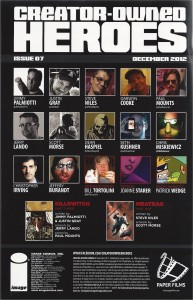
The combined tone and attitude of the comics and prose in CREATOR OWNED HEROES #7 avoids even the faintest whiff of defeatism. The series’ message is still going strong, and the works it presents don’t even aspire to meet the professionalism of company-owned comics, they aspire to go beyond company-owned projects in terms of high-quality story-telling, artwork and design. After all, what’s the point in trying to keep up with the Joneses when you really want to set a new standard all your own? As an experiment, the COH series is winding down, but the data is being collected, the procedure is nearly complete, and no one doubts the skill of the team involved. The increasing momentum generated in the pages of COH #7 has, certainly, guaranteed that no one will stop reading until the experiment is complete.
Hannah Means-Shannon writes and blogs about comics for TRIP CITY and Sequart.org and is currently working on books about Neil Gaiman and Alan Moore for Sequart. She is @hannahmenzies on Twitter and hannahmenziesblog on WordPress.
By: Ninja Librarian Bill,
on 12/3/2012
Blog:
Boys Rock, Boys Read!!!
(
Login to Add to MyJacketFlap)
JacketFlap tags:
Speaker For The Dead,
Jonah Hex,
For a Few Dollars More,
Lee Van Cleef,
Ender's Shadow,
Bury Me In Hell,
Orson Scott Card,
Ender's Game,
Clint Eastwood,
Justin Gray,
Jimmy Palmiotti,
Add a tag
Hi all you cool cats in "The Land o Blog." I've been travelling the waste lands all by my lonesome for a little while now, but have found the communication portal once again. Big shout out to Iron Carl for carrying the load all by his lonesome will I was missing in action!!!! Luv ya dude!!!! Anyway since I'm back I'd like to make this post a little special. Hold tight all:
For a Few Dollars More staring Clint Eastwood and Lee Van Cleef!!!!
After reading my first review you will understand why I included this awesome clip!!!!
Jonah Hex, Bury Me In Hell by Justin Gray, Jimmy Palmiotti and others - For those of you unfamiliar with Jonah Hex let me fill you in. Jonah Hex is the ultimate western anti-hero out there in the world of comics. This Graphic Novel covers the comics numbered 61-70. If you love the Spaghetti Westerns (The Good, the Bad and The Ugly, For a Few Dollars More and A Fistful of Dollars) made with Clint Eastwood, Lee Van Cleef and Eli Wallach (The very best with all 3 involved), you will love this Graphic Novel. This GN includes Jonah taking on a Killer Octopus (I know this one has you scratching your head), being stranded in a town where breakfast, lunch and dinner are more than a tad odd and plenty of other stories involving bandits, gunslingers, saloons, whiskey and general wild west adventure. I must caution that this book is not for younger readers as the violence, language and general mature level is definitely for older western fans. My recommendation would be at least 14 years old and up. If you like this one there are many other excellent Jonah Hex GNs out there. Great stuff!!!!!
 Speaker For The Dead by Orson Scott Card -
Speaker For The Dead by Orson Scott Card - Orson Scott Card is by far and away one of the finest writers of Science Fiction that I know. Now to me what makes for great Scfi is not just futuristic machines and gadgets, spaceships, etc., but also great written characters and a solid plot that peaks your interest. "Speaker For The Dead" has all of these items and I flew through it. Now if you are not familiar with "Ender's Game," the first book in which we meet Ender Wiggins and the war against the Buggers is held, stop right now and read that book first. I would also suggest following "Ender's Game" with "Ender's Shadow" about another interesting character named Bean. Okay after reading those two books dive into this one. This book is about what happens to Ender after The Bugger War ("Ender's Game" and "Ender's Shadow" occur at the same time, just focusing on different characters). He becomes what is called a Speaker of the Dead and tells the story of people's life that are no longer with us.

The story starts on a world know as Lusitania that is colonized by humans. The problem is there is an alien race already living their known as the Porquinhos or Piggies (although in no way or form do they resemble pigs) which means because of incidents that occurred in "Ender's Game," humans are forced by The Starway Congress to have limited contact with this newly discovered species. The limited contact that is allowed for study leads to quite a mystery. A mystery that involves death and causes great pain and suffering until it builds to multiple calls for the most famous Speaker of the Dead....Andrew Wiggins. also not known by many to be Ender (despised by many for reasons you will have to read about)!!!!!!! A great read that I thoroughly enjoyed. Recommended for those13 and up.
Well I missed you guys and I will be back soon. Let me know if you are reading something you really like by commenting on this post?
Peace all,
Bill
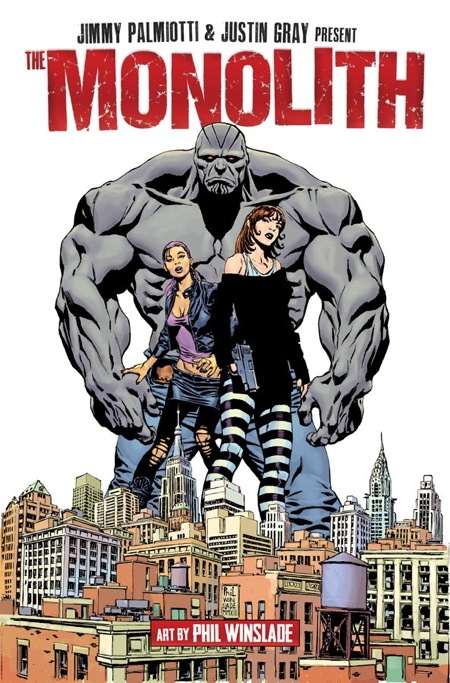
For years, writers Jimmy Palmiotti and Justin Gray have been running a “Get Monolith A Trade!” campaign to get their 12-issue maxi series from 2004 a collection. Although the book had a dedicated following—especially for fans of Phil Winslade’s amazing art—given that its sales were modest, that wasn’t the most likely outcome. However, on Facebook it’s revealed that rights have finally reverted and a collection is in the works from Image. Or rather — two collections, both in an oversized European hardcover album, like The Pro deluxe hardcover. The first will be out in July with the first four-issue storyline, including the double sized first issue and an introduction by Jim Steranko. The second volume will include the rest of the issues, minus the Batman crossover for a total of 9 issues reprinted. According to Palmiotti the oversized format was decided on to showcase Winslade’s intricate art.
MONOLITH is one of several former DC properties reverting to their copyright holders in recent years. While DC is definitely being gracious about allowing them to go back to the owners once they go out of print, it’s also an important reminder that with the right contract, you can get your stuff back.
Celebrating 15 years of Hellboy.
 This Friday, The Autumn Society invites you to the Hellboy 15th Anniversary show, only at Brave New Worlds! Because nothing says Happy Holidays like the beast of the Apocalypse!
This Friday, The Autumn Society invites you to the Hellboy 15th Anniversary show, only at Brave New Worlds! Because nothing says Happy Holidays like the beast of the Apocalypse!
Take a sneek peak at some of the pieces HERE









 The Beat: On another note, Harley Quinn has been a huge hit for DC and for the Paperfilms crew. I saw you talking recently about the fact that it has a lot of women readers. I know it’s all still anecdotal for DC but this audience seems to be one that is really growing quickly. Can you talk about your own experiences with that?
The Beat: On another note, Harley Quinn has been a huge hit for DC and for the Paperfilms crew. I saw you talking recently about the fact that it has a lot of women readers. I know it’s all still anecdotal for DC but this audience seems to be one that is really growing quickly. Can you talk about your own experiences with that?


























backed!